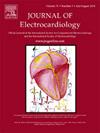基于ECG的人类活动特定心脏模式检测,使用机器学习和深度学习模型
IF 1.3
4区 医学
Q3 CARDIAC & CARDIOVASCULAR SYSTEMS
引用次数: 0
摘要
监测在放松、认知和身体压力下的心脏模式对于识别心脏压力或异常的早期迹象至关重要。本研究分析了在坐着、数学推理、散步、慢跑和骑自行车等不同活动中记录的心电信号,模拟这些压力源。提出了一种基于深度学习图像的卷积神经网络(CNN)模型,该模型利用基于双谱的轮廓来捕捉心脏行为的非线性动态,从而对心脏模式进行分类。采用了两种方法:基于特征的随机森林(RF)机器学习模型,使用时域、频域和统计特征,以及基于图像的CNN模型,利用基于连续小波变换(CWT)的尺度图和基于双谱的轮廓。特征选择技术,包括Pearson相关和最小绝对收缩和选择算子(LASSO)正则化,用于识别RF模型输入的重要特征。RF模型的准确率为96.80%,f1得分为92.22%。CNN模型在CWT尺度图上的准确率为98.44%,f1得分为96.11%;在基于双谱的轮廓图上的准确率为99.16%,f1得分为97.89%。应激指数和SNS-to-PNS比值等主要特征随着认知和身体应激源的增加而增加,突出了自主反应。基于分析结果,提出的基于双谱轮廓的CNN模型显示出卓越的准确性和可靠性,显示出在不同活动中监测心功能的巨大潜力。本文章由计算机程序翻译,如有差异,请以英文原文为准。

ECG based human activity-specific cardiac pattern detection using machine-learning and deep-learning models
Monitoring cardiac patterns under relaxed, cognitive, and physical stressors is crucial for identifying early signs of cardiac stress or abnormalities. This study analyzes ECG signals recorded during diverse activities such as sitting, math-reasoning, walking, jogging, and hand-biking, simulating these stressors. A deep-learning image-based convolutional neural network (CNN) model utilizing bispectrum-based contours was proposed to classify cardiac patterns by capturing the non-linear dynamics of cardiac behavior. Two approaches were employed: a feature-based random forest (RF) machine-learning model using time-domain, frequency-domain, and statistical features, and an image-based CNN model utilizing Continuous wavelet transform (CWT) based scalograms and bispectrum-based contours. Feature selection techniques, including Pearson correlation and least absolute shrinkage and selection operator (LASSO) regularization, were used to identify significant features for RF model input. RF model achieved 96.80 % accuracy and an F1-score of 92.22 %. CNN model outperformed it, achieving 98.44 % accuracy and a 96.11 % F1-score with CWT scalograms, and 99.16 % accuracy and a 97.89 % F1-score with bispectrum-based contours. Key features such as stress index and SNS-to-PNS ratio increased with cognitive and physical stressors, highlighting autonomic responses. Based on the results of analysis, the proposed CNN model with bispectrum-based contours demonstrated superior accuracy and reliability, showcasing significant potential for monitoring cardiac functions across diverse activities.
求助全文
通过发布文献求助,成功后即可免费获取论文全文。
去求助
来源期刊

Journal of electrocardiology
医学-心血管系统
CiteScore
2.70
自引率
7.70%
发文量
152
审稿时长
38 days
期刊介绍:
The Journal of Electrocardiology is devoted exclusively to clinical and experimental studies of the electrical activities of the heart. It seeks to contribute significantly to the accuracy of diagnosis and prognosis and the effective treatment, prevention, or delay of heart disease. Editorial contents include electrocardiography, vectorcardiography, arrhythmias, membrane action potential, cardiac pacing, monitoring defibrillation, instrumentation, drug effects, and computer applications.
 求助内容:
求助内容: 应助结果提醒方式:
应助结果提醒方式:


